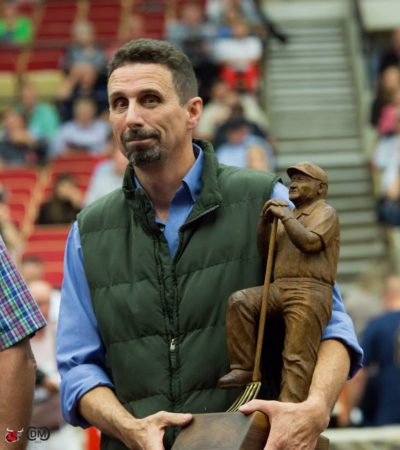
Richard was born February 19th, 1968, the son of Edgar Charles “E.C.” Caverly and Charlee (Ballard) Curtis. Richard graduated from Lawrence High School in 1986 and got straight to work in the dairy industry, first working at the family’s farm in Clinton.
Richard’s lifelong passion for cows began at home. During his youth, Richard was an active member of 4-H and helped the family exhibit their award-winning Ayrshire cattle at local fairs and regional cattle shows. He would often credit his farm and cattle knowledge to his father and his uncles, Frank and Pudge. They started their Ayrshire herd as a 4-H project that was their own responsibility, as their father was the head of the highway commission and constantly “on the road” They received help from his great-uncle Edgar; The brothers bred and developed many all-American and all-Canadian cattle, including the Royal Junior Champion in the ’60s and the 1978 Madison Grand Champion and Reserve Junior Champions. The farm is unique in that, along with these dairy champions, Richard’s cousins have had National Champion with their Beef Shorthorn cattle as well.” Richard appreciated these strong family ties. “I am blessed with amazing family support, all the way from my Uncle Frank to my youngest sister, Leah”, commented Richard.
Richard, the 23rd Duncan MacKenzie Award winner’s journey, began on his home farm, where he worked with the famous 97-point Ayrshire cow Belladina and the 1978 World Dairy Expo Champion Helga. Caverly then went on to work for farms in Massachusetts and Pennsylvania, as well as for dairymen in Brazil. In 2001, Caverly became the first herdsman for Arethusa Farm in Connecticut. After that, he moved back to his home state and worked for the 1,700-cow Flood Brothers Dairy and ABS Global.
The Northeast U.S. native travelled the world working with great cows, and he always made them his priority, no matter who owned them. Caverly worked with household names in the industry: Gold Prize, Nadine, Melanie, Delilah, Ashlyn, Victoria, Veronica, and Frannie. Those who have followed the show at the World Dairy Expo will know there are four Supreme Champions on that list. And the Glenamore Gold Prize holds a special place in the heart of this Maine native, as Caverly worked with her all five times; she was Grand Champion at the Royal Agricultural Winter Fair.
As a child, Richard was always chatting and questioning everything and never short of opinions, a trait that he held till his passing. Obsessed with cattle and pedigrees, especially Ayrshires, he idolized the people who worked with the great cattle and herds. The way he connected with people led him to work with the world’s greatest cattle and those cowmen he idolized. Nothing made him happier than the success of others, and in that way, he became one of the greatest cowmen in the business—a man a whole new generation of young men and women look up to. Richard took great pride in trying to help educate the next generation.
Richard married Beverly Donovan of Chesterfield, Massachusetts, in 2010. Together, they shared a deep passion for Ayrshire cattle and expanded Bev’s Deer Hill Ayrshire herd at Benton, Maine. They competed regularly at the Eastern States Exposition in West Springfield, MA, the World Dairy Exposition in Madison, WI, and the North American Livestock International Exposition in Louisville, KY, among others. The herd included Sweet Pepper Black Francesca, the two-time Ayrshire Grand Champion at the World Dairy Expo. Richard and Bev enjoyed tremendous success and created many special memories working together and alongside many friends and family at the shows.
Richard’s creative spirit shone brightly through his love for photography, his gift for poetry, and his creative approach to spoken language. His passion for dairy cows was reflected in his research and knowledge of the animals he admired and the farms that raised them. Richard served as a mentor to many young dairy farmers; his experience, guidance, and passion will live on in the lives he touched. Above all through these accomplishments, Caverly exemplified and will be remembered for his character, sportsmanship, ability, and endeavor.
Richard’s last post on Facebook is very telling: “Life is never bad if you have a handful of great friends”, and honestly, I have more than a handful!” Yes, Richard, you had many friends and admirers.
Richard Caverly not only succeeded but left an indelible mark on the world around him, and for that, we will be eternally grateful. Rest in peace, dear friend. Your light will continue to shine brightly in our hearts forevermore.
Richard was predeceased by his father Edgar and stepmother Donna Caverly, maternal grandparents Richard and Lottie Ballard, paternal grandparents Brainard Jr. and Evelyn Caverly, and cousin Dale Caverly. Survivors include his wife Beverly Donovan; mother Charlee Curtis; siblings Sara (John) Thompson, Anita (Norman) Burdzel, Robert (Dominique) Caverly, Russell (Jordan) Caverly, and Leah (Erick) Lafferty; four nephews and one niece; uncles Frank (Susie) Caverly and Rick (Victoria) Ballard; six cousins; and the many special friends who shared in his adventures.
The family would like to thank the numerous friends who regularly checked in on Richard and supported him throughout the years. Special appreciation to Tim and Erin Flood and their children, as well as to Prescott Tilton-Flood and Cody Mills.
Visiting hours will be held Friday, March 1st, from 1:00–3:00 pm, followed by a 3:00 pm service both at Moody Chapel on the Hinckley Campus of Kennebec Valley Community College. Family and friends will be invited to a reception to honor his memory following the service.
In lieu of flowers, donations can be made to the Richard Caverly Award Fund with the Ayrshire Breeders Association, 1224 Alton Darby Creek Rd., Columbus, OH 43228. Other donations in Richard’s name to support the dairy industry are welcome.











